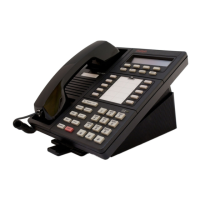MERLIN LEGEND Communications System Release 6.1
Feature Reference
555-661-110
Issue 1
August 1998
Features
Page 174Coverage
Figure 12. Phantom Calling Groups
Phantom Extensions 9
If more than 30 extensions require coverage to the operator, phantom extensions
can be used after the maximum number of phantom calling groups is reached.
This setup is slightly different from the previous two scenarios. In this case, the
published DID number is the number for the phantom extension. The actual
telephone has Shared SA buttons with the phantom extension as principal user,
so the call rings at the telephone with the SSA button. The operator covers the
phantom extension and can use the Direct Voice Mail feature to send calls to the
original extension’s voice mail.
To set up phantom coverage to the operator before going to voice mail, do the
following (see Figure 13
):
1. Assign the extension to a coverage group. Assign a Group Cover button to
the operator if the operator is a DLC, or assign the coverage group to ring
at the QCC.
2. Assign a phantom extension to a number (in Figure 13
, 214). You may
have to renumber the extension first. If the extension does not have an
adjunct, using the adjunct extension number helps avoid confusion. (see
“System Renumbering” on page 659
for details about adjunct extension
numbers.)
3. Assign Shared SA buttons for the phantom extension to the real extension.
(In Figure 13
, SSA buttons for 214 were assigned to 114.) Remove all but
one SA button for the real extension. You may want to make this a No Ring
Call comes in
for ext 101.
Rings at ext
101.
Covers to
Operator
Operator
transfers to
201 (Voice
Mail).
Operator
answers

